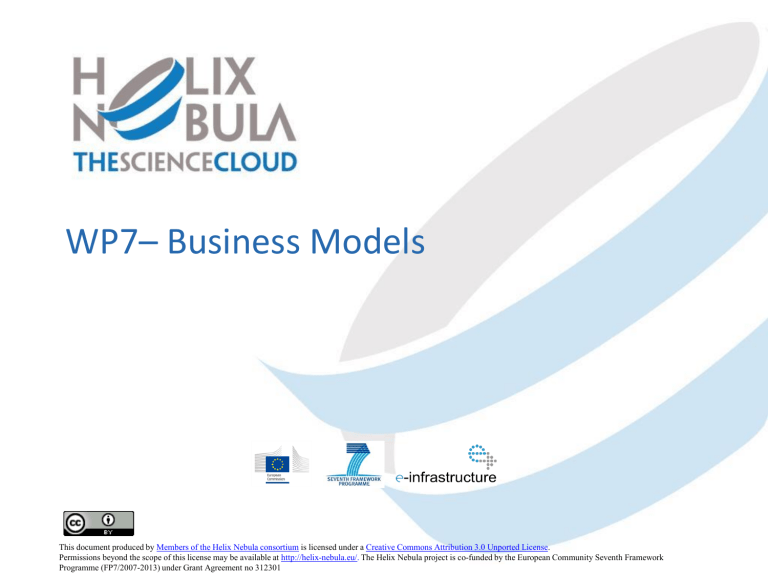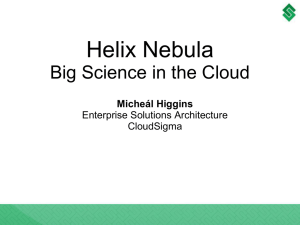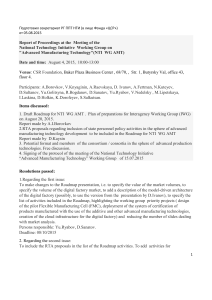WP3 * Representation of requirements - Indico

WP7– Business Models
This document produced by Members of the Helix Nebula consortium is licensed under a Creative Commons Attribution 3.0 Unported License .
Permissions beyond the scope of this license may be available at http://helix-nebula.eu/. The Helix Nebula project is co-funded by the European Community Seventh Framework
Programme (FP7/2007-2013) under Grant Agreement no 312301
WP Objectives
To produce and evaluate possible business models for public-private partnership and support the adoption of these through standard tender templates based on the approach defined in WP3 – note also the iteration between this WP and WP8.
Specific goals
Understand the financial implications of ‘utility computing’ for vendors and customers
Define mechanisms for quantifying and controlling risk
Assess the viability of standard cloud-service procurement templates across jurisdictions
Effort Contribution
Lead Beneficiary: SAP
WP7
12%
Person-Months per
Participant
Participant
SAP
Personmonths
23.00
TOTAL 23.00
PM2
WP7
PM24
Recommendations from P1 review
The type of services definition and their cost estimation, the requirements gathered in WP3, should be of reference (and eventually updated)
In the second period of the project, the
Framework Contract solution should be analysed with attention to anti-trust and competition regulations
The scenario where a PPP plays a coordination role is expected as well as possible launch of PPI
(public procurement for innovation) for cutting edge solutions (for a European Science Cloud)
Implementation of recommendations
Current service types and costs were considered in business case and in the business model roadmap as a starting point
Updated services: service extension based on roadmap from Iaas to InfoaaS.
Proposed procurement models which will be elaborated on in the potential Picse project
Scientific/technical achievements and their impact
Business model roadmap
Proven economic viability of Generic Cloud Computing for European Big
Science
Transition to InfoaaS based on roadmap to critical mass.
Defined broker, partner and platform roles for effective business operations.
Proposed procurement model which will be taken forward in the Picse project.
Deliverables and Milestones – Period 2
Type Del. no
Name Nature
Deliverable 7.2
Synthesis and Analysis of
Overall Business Models
Deliverable 7.3
Costing exercise comparing inhouse vs. cloud based operation for the CERN flagship use-case and incorporation of qualitative cloud adoption criteria targeting prospect members
Deliverable 7.4
Information as a Service –
Towards Value Co-Creation in a
European Cloud Computing
Platform Ecosystem
Report
Report
Report PU
Dissemination level
Date
Delivered
PU
PU
16.09.2013
20.02.2014
03.02.2014
Overall modifications, corrective actions, re-tuning of objectives
D7.3 Focusing on only one flagship CERN
(By choosing the organisation with assumed lowest costs we were able to show significant results)
D7.4 Elaborate on business models roadmap
(Since we proposed a business model roadmap it was crucial to show the transition between the first business models, instead of focusing on further business cases. )
Exploitation and use of foreground
(Results of Period one and next steps)
D 7.1
1.
Issue: Procurement
2.
Challenge: Switching Costs, Investment Risks / Commitment, Transp.
D 7.2
1. Procurement Models
2. Potential Broker Roles
3. Business Model Roadmap
D 7.3
3. Cost Analysis of current business model Generic Cloud Computing for
European Big Science
D 7.4
3. Transition from current business model to future business model InfoaaS based on network effects and reaching critical mass
9
Collaboration with other beneficiaries
Consortium
• Business Case
• Procurement
ESA
• Network Effects and reaching critical mass
EGI.eu
• Interoperability of public and commercial providers
Contribution to the dissemination of project results
We supported a master thesis on Helix Nebula focusing on the establishment of partner ecosystems written by
Michael Blaschke. This Master thesis might be integrated into a scientific paper later in the year.
Internal & external SAP News article on business model innovation to SAP customers and partners which will refer to the success of the project and its webpage
Journal article (360 degree) using Helix Nebula as case study for successful business model innovation
Business Model Innovation for
Helix Nebula D7.2
Business Model Roadmap
Short Term
Generic Cloud Computing for European Big Science
Objective of Helix Nebula. Further satisfying needs and requirements of CERN, EMBL and ESA
Information as a Service
Business model of interest to ESA and potentially other data intensive research organization.
Long Term
Versioned Cloud Computing for Science & Education
Addressing the entire world of science and education through explicit versioning of prices, revenue models, SLAs, and services.
Worldwide all-in-one enterprise cloud
The provision of resources to governments, businesses and citizens is a vision of Helix Nebula and hence, the extension of Helix Nebula to these customer segments could be incorporated as a long term strategy.
13
Public Procurement Models
Demand Supply
Atlas
Experiment
Genom
Analysis
IaaS 1 Providers
PaaS 2 & SaaS 3
Prov.
1 CERN would be the best choice due to Industry Policy Procurement
Third
Party
Procurement of ...
Shared
Elements
Individual
Elements
Earth
Observation
PPP/ PPI/ PCP
Bilateral Frameworks/
Group Framework 1
PPP / PPI / PCP
Group Framework
Bilateral Framework
Service Contracts
Framework Contracts
Generic Cloud Computing
Demand Supply
Genom
Analysis
IaaS 1 Providers
Third
Party
PaaS 2 & SaaS 3
Prov.
Earth
Observation
Atlas
Experiment
EMBL: Restricted tender
ESA: Through prime contractor, establishing a procurement relationship
Long Tail of
Science
CERN: Restricted Tender, enabled to procure for other research organizations - addressing long tail of science
Implementation of framework contracts or PPP take to long
Note: Tender does not assign budget to individual suppliers
Info as a Service
Supply
1
Funding mechanism to set up the ecosystem, develop first services, align data
IaaS 1
Providers
• <
PaaS 2 &
SaaS 3 Prov.
Third
Party
2
Once platform established same model utilized for Generic CC
IaaS 1
Providers
PaaS 2 &
SaaS 3 Prov.
Third
Party
Demand
Atlas
Experiment
Genom
Analysis
Earth
Observation
PPP/ PPI/ PCP
Genom
Analysis
Earth
Observation
Atlas
Experiment
Long Tail of Science
EMBL: Restricted tender
ESA: Through prime contractor
CERN: Restricted Tender, long tail of science
Economic Viability D7.3
Business Case Calculation
The private cloud based on OpenStack (IaaS) and Zenodo, a digital repository that offers permanent storage for research data for any science domain (SaaS). The private cloud is relying on other departments that are responsible for tendering, purchasing, customizing, deploying, operating, monitoring and maintaining (new) hardware. The SaaS solution Zenodo is in turn naturally depending on the Infrastructure (OpenStack cloud)
Technical specifications:
Private cloud (OpenStack): A virtual node with 2 cores, 8 GB memory, 80 GB local disk space (one 8th of a node)
Zenodo service: 10 VMs, 1 PB of disk space (Dropbox-like), 1.5 PB of
Archive Storage
Business Case Results
In contrast to CERN in-house
Open Stack IaaS Service
1 year commitment
Open Stack IaaS Service
3 year commitment
AWS
+ 19.4 times
+ 14.6 times
Helix Nebula
+ 5.6 times
+ 3.9 times
In contrast to CERN in-house
Zenodo SaaS Service
1 year commitment
Zenodo SaaS Service
3 year commitment
AWS
+ 30%
+ 30%
Helix Nebula
- 13%
- 36%
Note: Even without gathering all cost components, HN prices for the Zenodo service are very competitive
Roadmap to Critical Mass D7.4
Network Effects in INFOaaS
Data User
Community
Transparency
Best Practices
Gap Identification
Core Competency
Economies of Scale
Governance
Knowledge Sharing
Data Users
Laws
Directives
Citizen Alerts
Experts &
Non-profits
New Research Questions;
System Insight
Data Providers
Quality of
Research/Interorganisational
Research
Data Provider
Community
Federated
Infrastructure
Platform Operator
Platform Sponsors
Content Operators
Broker Roles
Governments
Technology
Partners
Financial
Partners
Pooled Cloud Computing Services
Consulting
Partners
Roadmap: Overview
Strategic Steps towards Market Tipping
Size of
Network
1
2
Implementation: Move Early
Adoption: Create User Balance
3 Scaling: Build Critical Mass
4 Competition: Extend Business Scope
4
1
2
3
Time
Critical
Mass
A community is expected to have enough momentum to become self-sustaining at about
15% from the target community opting in, whereby critical mass is linked to consumer’s expectations regarding the performance of a product or service, and the expected final size of the network (Mahler and Rogers 1999). As long as the critical mass point is not exceeded, demand synergies can only develop to a limited extent (Schoder 2000).
Appendix (as potential extension)
Competition in Markets with Network Effects
Different Competition: Competition in Markets with Network Effects is fundamentally different than in conventional, non-network industries.
Fierce Competition and Market Tipping: Network markets are characterized by early, fierce competition due to positive feedback loop inherent in network effects, wherein the biggest networks becomes even bigger. Once a leader becomes clear, bandwagons form, while new adopters begin to favor the leading product over rivals. The market is tipping in favor of one dominant firm or standard, whereas the best product or service doesn’t always win (e.g.
Playstation 2 vs. XBox).
Winner-take-all or winner-take-most markets: Network markets are often winner-take-all or winner-take-most markets with monopolistic tendencies of one firm dominating all rivals.
Leading Networks offer more value and might charge customers more, while they also might have substantial bargaining power over partners (e.g. Apple, controlling over 75 percent of digital music sales).
Roadmap: Implementation
First Mover Advantage scarce resources (data providers), technology leadership, build up switching costs.
Governance: Define Roles communicate where, how and with whom value can be co-created (IaaS, INFOaaS)
Establish a vivid Community prior to launch
HN Marketplace (HNX) is ideal for community development to start INFOaaS.
Scale and optimize data sets and services on the fly gather insights on further required data sets from customers and experts
Example: Sony’s PS 2 enjoyed an 18-month lead over XBox and succeeded in the market, whereas the technically superior PS3 showed up months after XBox 360 and resulted in losses for Sony.
A Niche as Starting Point
1.
Start with a niche by picking a specific target market and try to dominate it. DORIS seems to be a potential starting point for INFOaaS.
2.
Target a small community, e.g. a specific geographical location, a demographic or niche interest and reach critical mass before spreading to a second, a third and, eventually, open up to the rest of the world
3.
Envision how to logically expand into larger markets, but only do so when dominating the community. Recognition and momentum is needed to move into a larger segment. In established markets, focus on a single niche an incumbent is either over- or underserving.
4.
Never drop below 15%. For example, Facebook reached critical mass within a single university before it spread to a second one, and beyond. Thus, Facebook never dropped below the critical mass and secured user value.
Roadmap: Adoption
Governance
12-24 month roadmap indicating where own developments will occur signal long term commitment. Extend IaaS governance e.g security: ensure IP of data.
Develop Complementary Goods
Encourage technology partners to develop add-on solutions
Provide high quality content create high demand info services prior to launch based on available data (ESA, EMBL, PIC,..)
Attract major users / providers acquire prestigious participants such as World Bank, United Nations etc.
Offer price reductions or seed funding subsidise price sensitive segments such as research organisations, fremium offer
Roadmap: Scaling
Governance
Document benefits for participants to join such as potential Co-Innovation, Marketing, Sales,
PR,…. Define steps to trigger network effects.
Lower Entry Hurdles compatibility with leading standards (IaaS EC2 bride, EGI/Geant Integration)
Facilitate switch to HN
Success Stories, Influence Expectations
Demonstrate value that users achieve
Foster Exchange provide functionality to support the exchange between users, providers and experts such as collaboration rooms, chats, websites etc.
Win over next segments
Roadmap: Competition
Extend business Scope sequentially by leveraging the use user base as an asset to expand into adjacent markets. Remember never dropping below critical mass.
Example: Amazon way from an online bookstore towards an Online retailer of books, movies, music and games etc.
Never stop innovating! Define strategy to maintain business within a growing competitive environment. The differentiation as part of INFOaaS becomes more mature and HN needs to create new innovation to provide profitable products, not only to differentiate from competitors, but to compensate for the commoditization of some of the services HN provided initially. HN needs a process of continuous change and improvement. As INFOaaS matures, participants’ demands grow. Thus, innovation is needed to simply keep existing customers committed while also winning over new customers.
Complementation and knowledge sharing are ideally enabled by measures that improve the
flexibility and co-learning to cope with changing, loosely coupled partners. The orchestrator should proactively link unconnected partners from distant parts of the ecosystem (Ozcan and Eisenhardt 2009).






